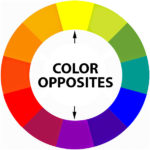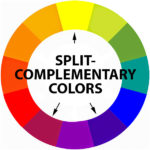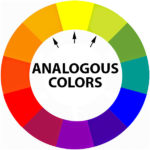Basic Art Element — Color, Part 2

What is Color Harmony?
Color harmony is the relationship of colors that work well together. It can be a elementary relationship involving only one color with several shades (monochromatic) or two complementary colors, or it tin can be a more circuitous human relationship involving multiple colors. There are many ideas for achieving harmony in our color palettes. These harmonies are based on the color wheel. A color wheel is a handy tool to have effectually every bit it helps the artist empathise which colors piece of work well together. Post-obit are some illustrations and descriptions introducing some of the more popular color harmonies.
Color Relationships
Monochromatic
Monochromatic refers to the utilize of a single color from the color wheel. A monochromatic color scheme can exist made using this single color.
A monochromatic colour scheme is created past using that single color along with its various tints, shades, and tones. All the variances of the single color work well together to produce a harmonizing and soothing effect.
Complementary

The complementary or color opposites are:
-
- Carmine and green
- Xanthous and violet
- Blue and orange
- Yellowish-green and red-majestic
- Yellowish-orange and blue-violet
- Cherry-orange and blue-green
- Carmine-violet and yellow-light-green
- Red-orange and blueish-green
- Blue-violet and yellow-orange
Painting tips regarding color opposites:
1) When equal amounts of color opposites are mixed, they will cancel each other out, resulting in a drab neutral grayness.
2) When color opposites are placed adjacent to each other, peculiarly when fully saturated, they create the strongest contrast betwixt them. They will even create the optical illusion of appearing to vibrate. This illusion is most evident between reddish and green.
Dissever-Complementary

This scheme allows for a wider range of colors while remaining true to the basic harmony between the cardinal and complementary colors. It has the same visual appeal as the complementary color scheme simply with less dissimilarity and tension. Split-complementary colour schemes are a safety choice for well-nigh any design because they are almost impossible to mess up and always wait skillful.
Analogous

Using this color scheme, choose one as the dominant colour (usually a primary or secondary color), a 2d color to support, and a third as an accent.
Accented Coordinating

Painting tips using this color scheme:
1) This color scheme works best when the number of colors used is limited to four.
2) A adept time to apply this scheme is when three closely related colors dominate a design. Then, calculation the contrasting color provides a surprising accent for the composition.
Triadic (Triad)

Some examples of triadic colour schemes could be:
-
- Red / Yellowish / Blue
- Orange / Light-green / Violet
- Yellow-Orange / Blueish-Green / Scarlet-Violet
- Yellowish-Green / Bluish-Violet / Red-Orange
Painting tips for mixing triad colors:
1) Work with simply the three selected colors in your triad and their mixes.
2) Make one of your colors dominant, with the other 2 interim equally subordinates.
3) Add variety to your pattern by including different shades, tints, and tones of your triad colors.
Test your cognition of color theory. Accept this unproblematic examination.
Your Next Art Lesson
If you lot enjoyed this lesson, exist sure to bank check out another one in this series.
The Basic Elements of Fine art (Introduction)
Basic Art Element — Colour, Part i
Basic Art Chemical element — Color, Role ii — Yous are here.
Basic Fine art Element — Line
Basic Art Element — Space
Basic Fine art Element — Texture
Basic Art Chemical element — Value
More Art Lessons
Good Design Principle: An Introduction
Good Design Principle: Remainder
Skillful Design Principle: Contrast
Adept Design Principle: Emphasis
Good Design Principle: Movement
Expert Design Principle: Proportion
Good Design Principle: Space
Good Blueprint Principle: Visual Economy
Proficient Blueprint Principle: Unity
Have a question?
If you have a question about this painting, please contact u.s., and nosotros'll be happy to answer any of your questions.
Thanks for reading this art lesson!
Feel free to share this with your friends.
UPDATED: 25 June 2021
Enjoy this page? Delight share information technology. Thanks!
Source: http://teresabernardart.com/basic-art-element-color-2/
0 Response to "Basic Art Element — Color, Part 2"
Enregistrer un commentaire